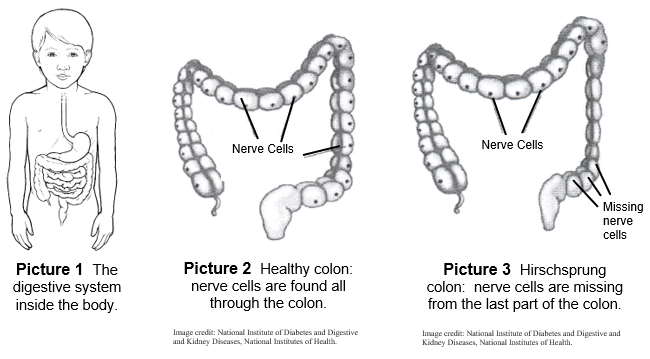Hirschsprung Disease (HD)

In Hirschsprung (HER shprung) disease, the nerves in the colon (also known as the large intestine or bowel) that move stool forward did not form. These nerves are called ganglion cells. They make the colon contract so stool can move easily through the digestive system (Picture 1). Hirschsprung disease can affect a small part of the colon or the entire colon. In rare situations, it can move into the small intestine, as well.
During digestion with a normal colon, stool will move all the way through the bowel (Picture 2). However, with Hirschsprung disease, healthy muscles and nerves of the colon push stool and gas through the colon until it reaches the part with no ganglion cells. At this point, the stool stops moving and gas builds up in the colon causing the healthy area of the colon to become larger. Usually, the part of the colon without ganglion cells is very narrow (Picture 3). Stool building up in the colon can cause serious problems, like infection.

Symptoms
- No bowel movement the first 48 hours of life
- Swollen belly (abdomen)
- Fever (100.4 degrees F or above)
- Abdominal pain
- Explosive diarrhea
- Foul-smelling stool
- Delayed growth
- Severe constipation
- Decreased appetite
Diagnosis
Many tests may be done to see if your child has this disease.
- Rectal exam – The doctor examines the rectum with a gloved finger.
- Contrast enema – Contrast material is put into the colon through a small tube inserted in the rectum. X-rays are taken while the contrast fills the colon. This test lets the doctor see the outline of the bowel and look for any problems.
- Anal manometry – A small tube with a balloon on the end is inserted into the rectum. The balloon is filled with air. This lets the doctor see if the nerves and muscles of the colon are working right.
- Rectal biopsy – A small piece of colon is removed and studied under a microscope to check for nerve cells. This biopsy is done in the operating room with the child asleep or at the bedside for newborn babies.
Infection
Infections can be very dangerous for children with Hirschsprung disease. An infection can cause irritation of the bowel lining. This infection is called enterocolitis (EN ter oh koe LIE tis) and it can happen before or after the surgery for Hirschprung disease.
Watch for the following signs of infection. Call your practitioner right away if you see:
- Underarm temperature over 101 degrees F
- Swollen belly
- Vomiting or diarrhea
- Bleeding from the rectum
- Child acts “sluggish” – no energy
Treatment and Surgery
Hirschsprung disease is treated with a surgery called a pull-through procedure. This surgery removes the part of the colon without nerve cells and connects the healthy colon to the rectum. It can be done through the opening of the anus. Sometimes, small incisions may need to be made on the belly so that the surgeon can see better with a scope instrument. Your child will be in the hospital for 3 to 7 days to recover from surgery.
- Some children that have a lot of their colon affected by Hirschsprung disease may need a colostomy or ileostomy before their pull-through surgery. This will keep stool away from the affected colon and help keep it from getting large and infected. With a colostomy or ileostomy, stool is passed into a bag through an opening on your child’s belly. For some children, the surgery can be done soon after diagnosis without a colostomy or ileostomy. Ask your nurse or health care provider for more information on ostomies.
- Some children may need irrigations of the colon until it is time for their pull-through surgery. This can help flush out the stool and gas that can block the colon.
After Surgery
- Before leaving the hospital, your child will be scheduled for a follow-up visit one month after the surgery with their nurse practitioner and surgeon. During this visit, the team will make sure the pull-through operation is healing well.
- If your child has a colostomy or ileostomy, it is typically taken down 6 to 12 weeks after the pull-through surgery. Your practitioner will help to schedule these follow-up visits.
- After surgery, your team will work with you and your child on bowel function. Your child may have some constipation (slow moving stool). This is treated with laxative medicine or colonic flushes. However, after surgery the colon or intestine may move very fast for some children. This is called hypermotility. It is treated with diet and medicines to slow down the stool. The team will help you know what your child may need to have a normal bowel pattern.
Hirschsprung Disease (HD) (PDF)
HH-I-139 ©1991, revised 2020, Nationwide Children’s Hospital



